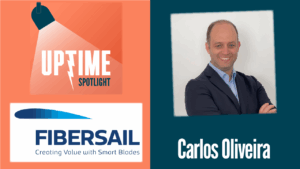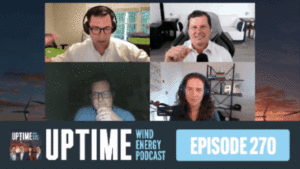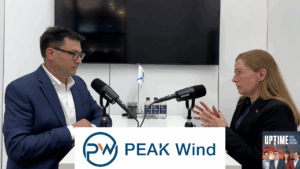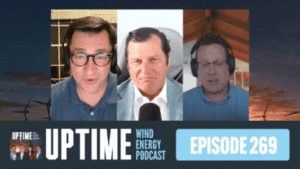Podcast: Play in new window | Download
We talk to CEO Simone Massaro about how BaxEnergy is revolutionizing renewable energy management. Their groundbreaking software solutions that are making clean energy more efficient and accessible. And the company’s recent acquisition by Yokogawa Electric Corporation will open doors for making their solutions better and more widespread.
Sign up now for Uptime Tech News, our weekly email update on all things wind technology. This episode is sponsored by Weather Guard Lightning Tech. Learn more about Weather Guard’s StrikeTape Wind Turbine LPS retrofit. Follow the show on Facebook, YouTube, Twitter, Linkedin and visit Weather Guard on the web. And subscribe to Rosemary Barnes’ YouTube channel here. Have a question we can answer on the show? Email us!
Pardalote Consulting – https://www.pardaloteconsulting.com
Weather Guard Lightning Tech – www.weatherguardwind.com
Intelstor – https://www.intelstor.com
Allen Hall: Welcome to the Uptime Wind Energy Podcast. I’m your host, Allen Hall, joined by my co host, Joel Saxum. Today, we’re honored to have with us Dr. Simone Massaro CEO of BaxEnergy. And BaxEnergy has established itself as a leading provider of software solutions for the renewable energy sector. Industry.
Since its founding in 2010, the company has been at the forefront of developing cutting edge asset performance and renewable energy management systems under Dr. Massaro’s leadership, BaxEnergy has gained recognition for its innovative approach to optimizing renewable energy assets, including wind farms and their solution helps energy companies monitor, analyze and enhance The performance of the renewable installations, ultimately making clean energy more efficient and accessible.
And in a significant development this year, BaxEnergy was acquired by Yokogawa Electric Corporation, a global leader in the industrial automation and control industry. This strategic move is set to bolster BaxEnergy’s position in the renewable energy market and open doors to new technologies and markets.
And that’s what I want to talk about today. Dr. Massaro is here today to share his insights on BaxEnergy’s journey. They’re groundbreaking work in renewable energy management and the exciting future ahead following the Yokogawa acquisition. Simone, welcome to the show. It’s great to be here. Thank you. Was that an adequate introduction?
Because you guys are doing so much at BaxEnergy. It is amazing the capabilities you’re providing to the renewable industry.
Simone Massaro: Yeah, I mean, BaxEnergy is essentially a software solution provider. And is focused on doing one thing and one thing only, which is making renewable energy more affordable for everyone.
And the way that we do that is by making the power plants more efficient. BaxEnergy is creating and delivering the software solution that is taking control of the renewable energy power plants, and is actually making them more efficient. In other words it’s taking all the aspects of the power plants that are difficult to handle the dark side of the renewable energy and is transforming it into something more efficient.
Our history as commenced about 10 years ago with the development of a solution, which was optimizing wind farms. And was focused on wind energy. And then from that, we evolved into solar energy, hydroelectrical energy, geothermal energy. And nowadays we’re working a lot with hydrogen, which is a little bit of the forefront of energy storage.
Not many people realize how difficult it is to work with renewable energy because renewable energy are by nature uncontrollable. The reason is that the source of the energy itself, the sun or the wind. They are at their source. They are uncontrollable. They are not depending on the will of the man.
So we we wanted to have energy on demand, but in reality, the sun is shining and the wind is blowing on a completely different schedule. So our focus is to make sure that it is possible to create a balance on the network by controlling this uncontrollable part of of nature. And we do that by mixing all the energy together.
Allen Hall: It’s been an amazing progression, because if you think about the complexity of the energy system we have today, and where we are going, and where we have been 10 years ago, right? The, the, the issue, the early issues, and still exist today. You have a lot of energy companies that have different assets that are manufactured at different times by different manufacturers, wind and solar in particular, the big two, integrating that into a useful system.
has been very difficult for, for operators to achieve. I think you’ve really bridged that gap now in, in terms of software. And that had to be a big hill to climb to do that. You want to explain how you accomplished that and how you kind of working that in software?
Simone Massaro: Yeah. So that’s that you, you make a very good point over there.
So, when the new energy we’re representing. A very small percentage of the global energy production. They were not creating a problem, but as the amount of renewable energy has grown to reach 10%, 20%, 30% in some countries, even 50% or more of the energy being produced, this is also increasing the fluctuation on the grid.
So the grid that we had before. Which was designed for big monolithic power plants was not sufficient to handle the fluctuation and the distribution of this renewable energy power plant. So, new technologies had to be invented to put this under control, not just the monitoring, but also the capability to shut down the power plants when when a wind farm was producing too much or when a solar power plant was producing too much to avoid fluctuation.
On on the grid. So the software somewhat evolved with these challenges. At the very beginning, we were focusing on gathering the data from the power plants. And the key focus really from the utilities was just to visualize this data. Later on the challenge came because Each of these power plant is, is typically produced by a different manufacturer.
Now, you have not only different technology clearly a wind turbine works in a very different way than the solar inverter and the hydroelectric power plant or geothermal power plant. But each of these power plant may actually be manufactured by a different OEM, by a different vendor, by a different original equipment manufacturer.
And each of this vendor is actually creating its own way to exchange data and its own way to control the power plant. It’s like having a different fleet of vehicles. So you can think of wind, solar and hydro making a relationship with the transportation. You can think of them as airplanes, cars.
And maybe trains and ships, essentially they’re all moving people from one place to the other, but they’re doing that in very different ways. And when you think of even just one of these categories, like cars, you don’t have a car, you have maybe 20, 30 different type of, of, of cars. You have utility vehicles, you have trucks, you have, very different size, very different objective, but also made up from different vendors.
So that, that’s the same thing that you have a renewable energy. And imagine now that you want a system to control all of these all of these equipments, all of these machines from one single place, that’s what the utility need. Because effectively, utilities are not buying just wind or just solar or just hydro.
They’re buying all of these technologies. They’re building all of them. And they’re not doing it with one vendor only. They’re doing it whichever offers the best price on the market. And as we started to work with utilities, we realized that That sometime utilities were having not, not one system, not two, not three, sometime 15, 20 different systems in order to monitor their power plants.
Because each of these power plant was coming with a different system. Each wind farm was equipped with his own monitoring and control system. Each solar power plant had his own power plant control system. So surely enough, if you have so many systems, you also need a lot of operators that they have to be trained to operate these different, these very different power plants coming from very different manufacturers.
So that challenges no one had solved before us. So early 2010, we came out with the first system. Which was unifying the monitoring and the control of different renewable energy sources all under one roof, regardless of the energy type, the technology type, the manufacturer, the vendor of that power plant, regardless of the communication protocol.
Regardless, even of things like unit of measurements, imagine a wind turbine produced in the U. S. will measure the wind speed in feet per second and one produced in Europe will measure it in meters per second. So you know, these, these, these utilities, these owners of the power plants, as the number of power plants was growing, they really needed to have that unified platform.
So that was the first challenge. That we addressed.
Allen Hall: You’ve grown as the industry has grown in terms of capability. Your first hurdle was trying to communicate everything to communicate with one another. So many different vendors, so many different technologies. It must’ve taken you an immense amount of time to even get that to work.
Just to get the data. Just to get the data, right. And to make sure that it works. Properly, but then to take that knowledge and then explode it into making sure the grid is more stable. That’s amazing.
Simone Massaro: Yeah. And surely enough it’s taken a lot of of people actually have the calculation of that.
So to do the, the data collection, the, the capability that we have today is to interconnect every single vendor that exists in the market. Every single winter turbine buying and inverter manufacturer. That produces inverted today in the world. Do we have a protocol for that? So it took us exactly 165 men years to produce this, which we call the universal data engine, and we did that over time in the course of three and a half years.
But you know, it was a very intense challenge. Once this challenge was resolved, anything else after that, it’s, it’s simple.
Allen Hall: Yeah. After 165 man years, I suppose so, but that’s a huge amount of knowledge that’s into your software platform today, which I think then makes you really powerful and make, this is the big issue.
The United States and Europe and even Australia has this issue more recently of grid reliability combined with when, when to use energy storage, how to apply that to a complex grid. Texas has this problem right now, Joel.
Joel Saxum: It’s what we talk about all the time in like the next evolution of grids in general to this smart grid version.
There’s an integration of hardware and software there, but you guys, software wise, you’re out in front of the game. You’re probably at some level waiting for the hardware that’s out in the field to catch up to what you can offer.
Simone Massaro: Yeah, to a certain extent, yes. So, in reality, what we have developed is an intelligent brain that is composed of two parts.
It is a central part that runs inside the core system of the utility, the owner of the power plants. And that’s the central brain that is orchestrating everything. And then there are smaller brains, smaller pieces of software that are running inside the power plants. So the two of them are communicating in a very secure way, in a very trusted way, has to be super secure because you’re not just reading the data, you’re actually exposing the capability of controlling the power plant.
And the, of course you have to synchronize from a central location, all these plants, you have to have communication is not avoidable, but it has to be super secure. Because if it is not. And any curve can actually enter into the power plant that could accidentally or on purpose shut down the power plant could create a damage, could create a ripple effect, which will lead to a larger scale blackout, such as some that have occurred in the United States years ago.
That’s also the reason why today this is a market in which a lot of very stringent regulation exists. Now, each country is creating its own regulation. In the U. S., you have the NERC Cybersecurity Standards for Power Plant. And in Europe, you have some others. And, as you go in Asia, you have some more.
So, because we started very early on and we wanted to work worldwide, we adapted our software to all of the cybersecurity standards that exist worldwide. So, companies and nations worldwide started to utilize our technology. And, today, we You know, we brought ourself to have, more than a single digit of the entire world energy generation.
In fact, we are approximating 3. 5 percent of the total renewable energy in the world currently being monitored by our software. Now it appears like a small amount where I can assure you being an independent vendor, it’s One of the largest in the market.
Joel Saxum: Yeah, that’s great. So that leads us to the Yokogawa merger the acquisition there So you guys now you’ve you’ve selected of basically a partner to join up with to grow the solution How is that going to work for you guys?
Simone Massaro: Yeah, so that’s if you if you look at the world the control of renewable energy is Is a an objective for for everyone. So the world is polarizing You And in three, maybe maximum five conglomerates of technological providers that are able to solve this challenge, and we’re one of them.
So what we thought was the best way for us was to create an industrial partnership. So we started to look around the four industries that were interested in this technology and sure enough, we found out the most in the industry that is interested the most in. In renewable energy are these heavy heavy industries that are consuming large amount of of energy.
Think about the aluminum foil foiling industries or think about all of the industries in which you are producing a large amount of metals or, or you have to cool down, refrigerate. You have to. Create larger scale productions that consume large amount of energies and all of these industries, they’re all looking for.
How do we decarbonize our operations? How do we reduce our cost? How do we get away from utilizing oil and gas and burning them in order to generate our energy to to do this? And Yokogawa is actually a technology provider that is offering DCS solutions and distributed control systems to this industry.
So it’s already present in all of the heavy industries, in all of the oil and gas industries, in all of the heavy machinery, heavy equipment, heavy metal. Water clarification plant, anything that really consumes an enormous amount of energy. And they were looking for a solution to help their customer decarbonize.
So we basically found the perfect match and we created a bond through an acquisition. So Yokogawa acquired 100 percent stakes of BaxEnergy, a little more than two months ago. And the goal of this acquisition is to create a new scale operations. From one side, Yokogawa will distribute our technology to renewable energy providers, independent power plant suppliers.
worldwide. From the other side, we will supply them the technology that they need to decarbonize the heavy
Allen Hall: industries. Well, that’s truly amazing because I think that is a perfect match of capabilities and industry and connecting the two together to broaden out this technology and get it to all corners of the world.
Because it is going to be, as you have pointed out, a renewable future. And in order to have a reliable grid, you need to control these assets properly. And this is the beauty of BaxEnergy, I think, is how well you orchestrate all these different technologies together. for efficient use and BaxEnergy is going to be leading that way.
How do future customers of yours find you? Where do they find you on the web?
Simone Massaro: Yeah, so they, they can find us in two ways on the BaxEnergy website, which is BaxEnergy. com very easy. Or they can actually look us over to the Yokogawa website. There is www. BaxEnergy. com. Right now one way to reach us we are entering several markets participating into all the most important trade shows and conferences on renewable energy.
And we find out that there is a great way to meet people, to speak with with the owners of the power plants and the, the, the operation and maintenance teams that have to run the power plants. And from these conversations. We’re driving our our growth to, to be even more precise on this point.
I’m going to be for a minute. What I tell every, every day to my engineers, to my software developers, to everyone else, don’t worry about the revenues. There are people that are taking care of it. Don’t worry about that. Just worry about making the best product possible for our customers. And then all the rest.
will flow by itself. And that’s really what has happened. We’re focused only on making the best possible product. And that’s why, the sales have been growing and, we got to the interest of all of these utilities and now all of these industrial partners. When you do something good, when your interest is aligned with the interest of your customer, then everything else is easy.
And I will go one step ahead, because in this case, our interest is aligned with the interest of the world. Because our, our motto is really making renewable energy more affordable to make a greener world for everyone. That’s really our goal. It’s solutions for a greener world. And even you guys that are listening to webcast right now, even if you’re not utilizing this solution, you will benefit from our technology indirectly.
Allen Hall: That is so true. And congratulations to BaxEnergy and Yokogawa. This is a great matchup. And Simone, I really appreciate you coming on to the podcast. It’s been really informative. I’ve learned a ton. And let’s stay in touch because. Backsynergy is growing and it’s going to be growing in leaps and bounds, and it’s been a pleasure.
Simone Massaro: Thank you so much. It’s been my pleasure. Thank you to everyone that is listening, and have a good day, everyone.











